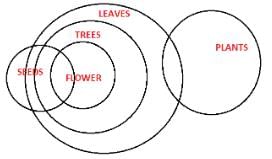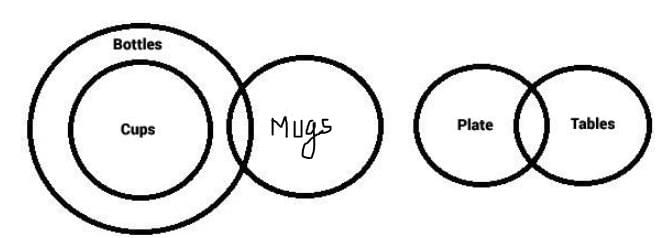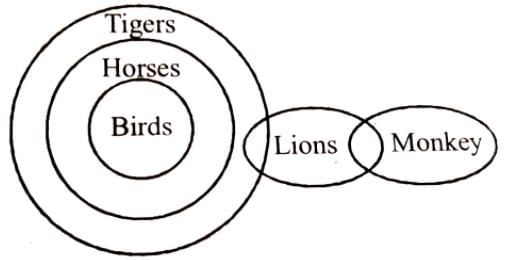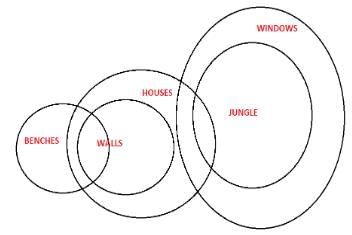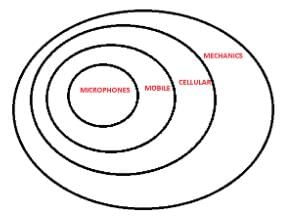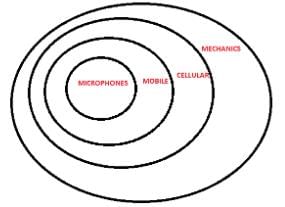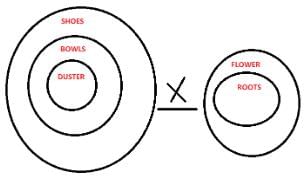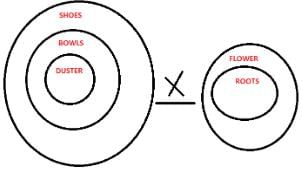Test: Syllogism- 1 - CLAT MCQ
15 Questions MCQ Test Logical Reasoning for CLAT - Test: Syllogism- 1
In each of the questions below given four statements followed by three conclusions numbered I, II and III. You have to take the given statements to be true even if they seem to be at variance from commonly known facts. Read all the conclusions and then decide which of the given conclusions logically follows from the given statements disregarding commonly known facts.
Q.
Statements:
All cards are notes.
All notes are tyres.
All tyres are books.
All books are rods.
Conclusions:
I. Some rods are notes.
II. Some books are tyres.
III. Some tyres are cards
Q.
Statements:
All cards are notes.
All notes are tyres.
All tyres are books.
All books are rods.
Conclusions:
In each of the questions below given four statements followed by three conclusions numbered I, II and III. You have to take the given statements to be true even if they seem to be at variance from commonly known facts. Read all the conclusions and then decide which of the given conclusions logically follows from the given statements disregarding commonly known facts.
Q.
Statements:
Some seeds are flowers.
All flowers are trees.
All trees are leaves.
Some leaves are plants
Conclusions:
I. Some plants are flowers.
II. Some leaves are seeds.
III. Some leaves are flowers.
Statements:
Some seeds are flowers.
All flowers are trees.
All trees are leaves.
Some leaves are plants
| 1 Crore+ students have signed up on EduRev. Have you? Download the App |
In each of the questions below given four statements followed by three conclusions numbered I, II and III. You have to take the given statements to be true even if they seem to be at variance from commonly known facts. Read all the conclusions and then decide which of the given conclusions logically follows from the given statements disregarding commonly known facts.
Q.
Statements:
Some lenses are poles.
All poles are skies.
Some skies are boxes.
No box is a bottle.
Conclusions:
I. Some bottles are lens
II. Some boxes are poles.
III. No bottle is a lens.
Statements:
Some lenses are poles.
All poles are skies.
Some skies are boxes.
No box is a bottle.
In the questions below are given four statements followed by for conclusions numbered I, II, III and IV. You have to take given statements to be true even if they seem to be at variance from commonly known facts. Read all the conclusions and then decide which of the given conclusions logically follows from the given statements disregarding commonly known facts.
Q.
Statements:
All cups are bottles.
Some bottles are mugs.
No mug is a plate.
Some plates are tables.
Conclusions:
I. Some tables are bottles.
II. Some plates are cups
III. No table is a bottle.
IV. Some mugs are cups.
In the questions below are given four statements followed by for conclusions numbered I, II, III and IV. You have to take given statements to be true even if they seem to be at variance from commonly known facts. Read all the conclusions and then decide which of the given conclusions logically follows from the given statements disregarding commonly known facts.
Q.
Statements:
All birds are horses.
All horses are tigers.
Some tigers are lions.
Some lions are monkeys.
Conclusions:
I. Some tigers are horses.
II. Some monkeys are birds.
III. Some tigers are birds.
IV. Some monkeys are horses.
In the questions below are given four statements followed by for conclusions numbered I, II, III and IV. You have to the take given statements to be true even if they seem to be at variance from commonly known facts. Read all the conclusions and then decide which of the given conclusion logically follows from the given statements disregarding commonly known facts.
Q. Statements:
Some Clothes are lamps.
Some flowers are lamps.
Some lamps are dresses.
All dresses are shirts.
Conclusions:
I. Some shirts are Clothes
II. Some shirts are flowers.
III. Some flowers are Clothes.
IV. Some dresses are Clothes.
In each of the questions below are given four statements followed by for conclusions numbered I, II, III and IV. You have to the take given statements to be true even if they seem to be at variance from commonly known facts. Read all the conclusions and then decide which of the given conclusion logically follows from the given statements disregarding commonly known facts.
Q.
Statements:
Some benches are walls.
All walls are houses.
Some houses are jungles.
All jungles are windows.
Conclusions:
I. Some windows are benches.
II. Some jungles are walls.
III. Some houses are benches.
IV. Some windows are houses.
In each of the questions below are given four statements followed by for conclusions numbered I, II, III and IV. You have to take given statements to be true even if they seem to be at variance from commonly known facts. Read all the conclusions and then decide which of the given conclusion logically follows from the given statements disregarding commonly known facts.
Q.
Statements :
No cream is a lemon.
All lemons are onions.
All cream is a grapes.
Conclusion :
(i) Some grapes are not onions.
(ii) All lemons are grapes is a possibility
In each of the questions below are given four statements followed by for conclusions numbered I, II, III and IV. You have to the take given statements to be true even if they seem to be at variance from commonly known facts. Read all the conclusions and then decide which of the given conclusion logically follows from the given statements disregarding commonly known facts.
Q.
Statements :
Some trees are mangoes.
All mangoes are bananas.
All tomatoes are bananas.
Conclusions:
(i) All trees are tomatoes is a possibility.
(ii) No bananas are tree is a possibility.
In each of the questions below are given four statements followed by for conclusions numbered I, II, III and IV. You have to the take given statements to be true even if they seem to be at variance from commonly known facts. Read all the conclusions and then decide which of the given conclusion logically follows from the given statements disregarding commonly known facts.
Q.
Statements :
All mobiles are cellular.
All cellular are mechanics.
All microphones are mobiles.
Conclusions :
(i) No microphone is mechanic is a possibility.
(ii) Some microphones are not cellular.
In each of the questions below are given four statements followed by for conclusions numbered I, II, III and IV. You have to the take given statements to be true even if they seem to be at variance from commonly known facts. Read all the conclusions and then decide which of the given conclusion logically follows from the given statements disregarding commonly known facts.
Q.
Statements :
All mobiles are cellular.
All cellular are mechanics.
All microphones are mobiles.
Conclusions :
(i) Some mechanics which one mobiles are also a part of microphones.
(ii) All microphones are cellular.
In each of the questions below are given four statements followed by for conclusions numbered I, II, III and IV. You have to the take given statements to be true even if they seem to be at variance from commonly known facts. Read all the conclusions and then decide which of the given conclusion logically follows from the given statements disregarding commonly known facts.
Q.
Statements :
All pencils are pens.
Some pens are stickers.
All stickers are numbers.
Some number are erasers.
Conclusions :
(i) Some numbers are pens.
(ii) Some numbers are stickers.
In each of the questions below are given four statements followed by for conclusions numbered I, II, III and IV. You have to the take given statements to be true even if they seem to be at variance from commonly known facts. Read all the conclusions and then decide which of the given conclusion logically follows from the given statements disregarding commonly known facts.
Q.
Statements :
All dusters are bowls.
All bowls are shoes.
No shoe is a root.
All roots are flowers.
Conclusions :
(i) No flower is a bowl.
(ii) All dusters are shoes.
In each of the questions below are given four statements followed by for conclusions numbered I, II, III and IV. You have to the take given statements to be true even if they seem to be at variance from commonly known facts. Read all the conclusions and then decide which of the given conclusion logically follows from the given statements disregarding commonly known facts.
Q.
Statements :
All dusters are bowls.
All bowls are shoes.
No shoe is a root.
All roots are flowers.
Conclusions :
(i) No duster is a root.
(ii) All flowers are root.
In each of the questions below are given four statements followed by for conclusions numbered I, II, III and IV. You have to the take given statements to be true even if they seem to be at variance from commonly known facts. Read all the conclusions and then decide which of the given conclusion logically follows from the given statements disregarding commonly known facts.
Q.
Statements :
Some mails are chats.
All uploads are chats.
Conclusions :
(i) All mails being uploads is a possibility.
(ii) No upload is a mail.
|
34 videos|85 docs|70 tests
|
|
34 videos|85 docs|70 tests
|



